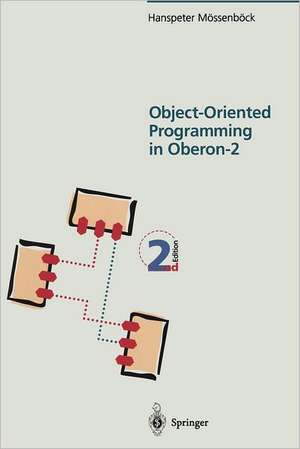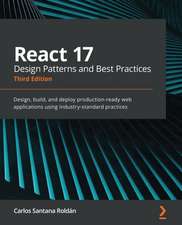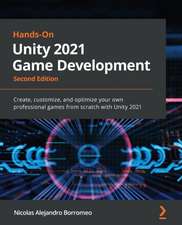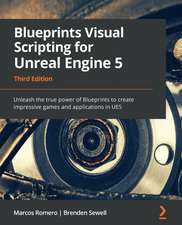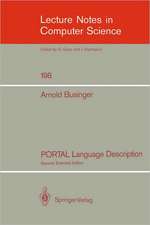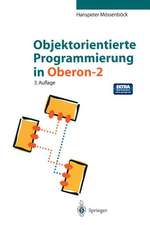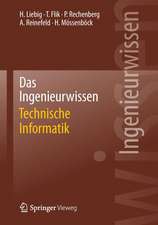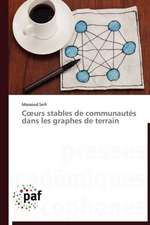Object-Oriented Programming in Oberon-2
Traducere de R. Bach Autor Hanspeter Mössenböck Cuvânt înainte de N. Wirthen Limba Engleză Paperback – 7 sep 1995
Preț: 336.21 lei
Preț vechi: 420.26 lei
-20% Nou
Puncte Express: 504
Preț estimativ în valută:
64.35€ • 69.93$ • 54.09£
64.35€ • 69.93$ • 54.09£
Carte tipărită la comandă
Livrare economică 21 aprilie-05 mai
Preluare comenzi: 021 569.72.76
Specificații
ISBN-13: 9783540600626
ISBN-10: 3540600620
Pagini: 296
Ilustrații: XIII, 278 p. 14 illus.
Dimensiuni: 155 x 235 x 16 mm
Greutate: 0.52 kg
Ediția:Softcover reprint of the original 2nd ed. 1995
Editura: Springer Berlin, Heidelberg
Colecția Springer
Locul publicării:Berlin, Heidelberg, Germany
ISBN-10: 3540600620
Pagini: 296
Ilustrații: XIII, 278 p. 14 illus.
Dimensiuni: 155 x 235 x 16 mm
Greutate: 0.52 kg
Ediția:Softcover reprint of the original 2nd ed. 1995
Editura: Springer Berlin, Heidelberg
Colecția Springer
Locul publicării:Berlin, Heidelberg, Germany
Public țintă
Professional/practitionerCuprins
1 Overview.- 1.1 Procedure-Oriented Thinking.- 1.2 Object-Oriented Thinking.- 1.3 Object-Oriented Languages.- 1.4 How OOP Differs from Conventional Programming.- 1.5 Classes as Abstraction Mechanisms.- 1.6 History of Object-Oriented Languages.- 1.7 Summary.- 2 Oberon-2.- 2.1 Features of Oberon-2.- 2.2 Declarations.- 2.3 Expressions.- 2.4 Statements.- 2.5 Procedures.- 2.6 Modules.- 2.7 Commands.- 3 Data Abstraction.- 3.1 Concrete Data Structures.- 3.2 Abstract Data Structures.- 3.3 Abstract Data Types.- 4 Classes.- 4.1 Methods.- 4.2 Classes and Modules.- 4.3 Examples.- 4.4 Common Questions.- 5 Inheritance.- 5.1 Type Extension.- 5.2 Compatibility of a Base Type and its Extension.- 5.3 Static and Dynamic Type.- 5.4 Run-Time Type Checking.- 5.5 Extensibility in an Object-Oriented Sense.- 5.6 Common Questions.- 6 Dynamic Binding.- 6.1 Messages.- 6.2 Abstract Classes.- 6.3 Examples.- 6.4 Message Records.- 6.5 Common Questions.- 7 Typical Applications.- 7.1 Abstract Data Types.- 7.2 Generic Components.- 7.3 Heterogeneous Data Structures.- 7.4 Replaceable Behavior.- 7.5 Adaptable Components.- 7.6 Semifinished Products.- 7.7 Summary.- 8 Useful Techniques.- 8.1 Initialization of Objects.- 8.2 Extending a System at Run Time.- 8.3 Persistent Objects.- 8.4 Wrapping Classes in Other Classes.- 8.5 Extensibility in Multiple Dimensions.- 8.6 Multiple Inheritance.- 8.7 Models and Views.- 8.8 Iterators.- 8.9 Modifying Inherited Methods.- 9 Object-Oriented Design.- 9.1 Functional Design.- 9.2 Object-Oriented Design.- 9.3 Identifying the Classes.- 9.4 Designing the Interface of a Class.- 9.5 Abstract Classes.- 9.6 Relationships between Classes.- 9.7 When to Use Classes.- 9.8 Common Design Errors.- 10 Frameworks.- 10.1 Subsystems and Frameworks.- 10.2 The MVC Framework.- 10.3 A Framework forObjects in Texts.- 10.4 Application Frameworks.- 11 Oberon0 — A Case Study.- 11.1 The Viewer System.- 11.2 Handling User Input.- 11.3 A Text Editor.- 11.4 A Graphics Editor.- 11.5 Embedding Graphics in Texts.- 12 Costs and Benefits of OOP.- 12.1 Benefits.- 12.2 Costs.- 12.3 The Future.- A Oberon-2 — Language Definition.- A.1 Introduction.- A.2 Syntax.- A.3 Vocabulary and Representation.- A.4 Declarations and Scope Rules.- A.5 Constant Declarations.- A.6 Type Declarations.- A.7 Variable Declarations.- A.8 Expressions.- A.9 Statements.- A.10 Procedure Declarations.- A.11 Modules.- A.12 Appendices to the Language Definition.- B The Module OS.- C The Module IO.- D How to Get Oberon.
Textul de pe ultima copertă
Object-oriented programming (OOP) tends to improve software quality by promoting structure, extensibility, and reusability of software. Its fundamentals are data abstraction, inheritance and dynamic binding. But it is not enough to understand these concepts; one must also learn how to make good use of them. This book covers the basic concepts of OOP, schows typical application patterns, gives useful design hints, and finally presents the design and implementation of an object-oriented windows system with an integrated text and graphics editor. The language used throughout this book in Oberon-2, a clean and type-safe language designed at ETH Zürich. However, the emphasis of the book is not on the language but on the concepts of OOP. They can easiliy be transferred to any other object-oriented language. The book is aimed at students of computer science as well as at practitioners who want to gain a perspective on modern software development techniques. Compilers for Oberon-2 as well as the source code of the case study in this book are freely available for several common workstations. The book is aimed at students of computer science as well as at practitioners who want to gain a perspective on modern software development techniques.
